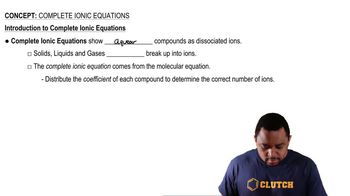Here are the essential concepts you must grasp in order to answer the question correctly.
Acid-Base Reactions
Acid-base reactions involve the transfer of protons (H+) between reactants. In this context, HCHO2 (formic acid) acts as an acid, donating a proton, while NaOH (sodium hydroxide) serves as a base, accepting the proton. Understanding the roles of acids and bases is crucial for writing balanced equations.
Recommended video:
Complete Ionic Equations
A complete ionic equation represents all the ions present in a solution during a reaction. It shows the reactants and products in their ionic forms, highlighting the dissociation of soluble ionic compounds. This step is essential for identifying the species involved in the reaction before simplifying to the net ionic equation.
Recommended video:
Net Ionic Equations
A net ionic equation focuses on the species that actually participate in the reaction, omitting spectator ions that do not change during the reaction. By removing these non-reactive ions, the net ionic equation provides a clearer picture of the chemical change occurring, which is particularly useful in acid-base reactions.
Recommended video:




